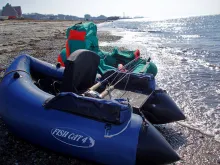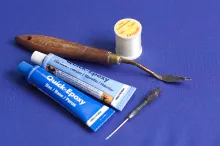Chris Edghill writes: "Fascinating to see how they worked together, one would dive in between the rocks and sea grass, completely burying itself and the others just milled around waiting for a shrimp to dart out from it's hiding place where it would be quickly devoured."
Having had the fortune of being born on the island of Barbados and family roots deeply imbedded in the local fishing culture I feel quite at home standing on a beach with a fly rod in hand. This is where most people find thing a bit daunting. The transition from river fishing where there are defined areas that fish are localized, like heads and tails of pool, rifles, visible flow lines etc to an expanse of seemingly monotone water is a bit frightening.
My grandfather, was once heard to say "fish have fins, so there ain't no need to move around to find them. Let'm come to ya".
Well, where this may be true of some species and their habits, I find it hard to remain in one spot while fishing for sea trout along the Baltic and Öresund coast. I prefer the adage " Better one cast on 10 different places than 10 cast on 1 pace". Choosing those places, reefs, boulders, bays or whatever, is difficult and important. Knowing where fish go and what they eat during the season is also a life long search that continues to haunt us as well.
During mid to late summer small glass shrimp start to appear in numbers along the cost, congregating in sheltered bays and harbours to the delight of both fish and fisherman.
Drifting past some submerged boulders one dreamy day on my float tube, I observed several trout around 1.5- 2.5 kg chasing these shrimp out from their hiding places. Fascinating to se how they worked together, one would dive in between the rocks and sea grass, completely burying itself and the others just milled around waiting for a shrimp to dart out from it's hiding place where it would be quickly devoured.
I watched one fish follow for several meters after one shrimp, until it nearly reached the surface where it made it's final attack in a decided splashing swirl. Presumably to corner it against the surface. This is what alerted me to their being there in the first place.
Being and avid reader of the Global FlyFisher and having reading the article Honey Shrimp By Kasper Mühlbach, witch is a fantastic fly, I was drawn to the conclusion that all the right triggers were there but not enough translucency like the real shrimp. So after much research, pictures of naturals, cursing over epoxy messes on my wives table cloth etc, I came up with this versions I call it the "S.L.S" short for "Sun Light Shrimp".
With it's characteristic see-through hump in it's back, egg sack, live heart and lots of movement from the gill, legs and antenna, fish just cant resist.
Shrimp move forward in their natural movement almost walking through water, hence the forward tying. Only when they are escaping do they propel themselves backward in short erratic bursts. This is also a good trigger to the fish. If the food is moving slow and forward then it has not been disturbed and may not getaway. Fish tend to cruse up to the fly and then smash it without hesitation.
I usually tie several at one sitting, that's the easy part. Then I will take a break and return later to set up the epoxying. Mixing only small amounts at a time is made a little easier if you use a painter's knife as shown in the picture. Remember, epoxy is extremely allergy causing, so don't get it on you - anywhere!
Use acotone to remove it before you take that long deserved toilet break.
Tight lines
Chris
- Log in to post comments




















Gentjan,
This is
Gentjan,
This is an old article, and we have no step-by-step pictures of the tying sequence, and have no plans of doing any. There will be new patterns with illustrated instructions, but this old one will remain as it is.
Martin
Can you put some pic
Can you put some picture during the production of it.... it looks really great..:)
Would you sell any o
Would you sell any of your SLS shrimp? I am NOT a tier at all but would love to try them on Bone fish when I go to Honduras this summer.
would be a good spec
would be a good spec trout and redfish fly too
great fly i love the
great fly i love the detail will start making some to try in oz
Very nice and well d
Very nice and well done...But (there is always a but) this shrimp, since it'is used a bendback hook, will not swim upside down?
From what I know shr
From what I know shrimp swim forward, but flee backwards (using their tail).
/atli
Nice fly ! but why
Nice fly ! but why not ty this fly reverse ? ( shrimp are "swimming" backwards...)
Cornelis van Leeuwen
The Netherlands
Chris,
You should
Chris,
You should try Tuffleye instead of epoxy.
Much easier to apply, has infinite working time, can be set in 20-30seconds WHEN REQUIRED, is perfectly clear, doesn't yellow, non-allergenic, and is tougher than epoxy
(no financial interest unfortunately!)
I use it for all my surf candies, poxy shrimps etc
It will turn your tricky part into a breeze
Anselmo
Nicely done.
Nicely done.
... and one more ver
... and one more very frosty winter evening is done. Great idea which I will try out very soon - tying and fishing wise. Thanks.
Ole
Hi Chris,
Very ve
Hi Chris,
Very very nice shrimp fly - I'm gonna give it a try and tie up a few :o)
Thanks
Bo
sls shrimp flie
Would like to know if I could purchase the sls shrimp fly from a fly tier ????